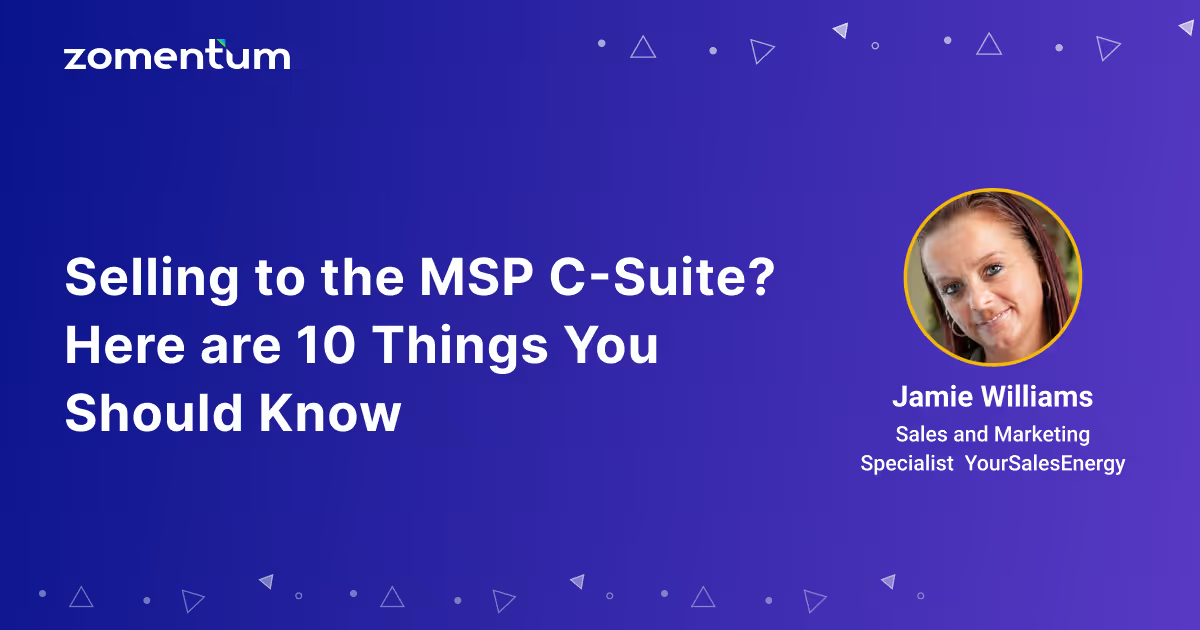Selling to the MSP C-Suite? Here are 10 Things You Should Know

C-level sales is an art.
While the sales process is likely to move faster - you’re talking to the key decision-maker after all - the conversation requires a level of maturity.
Many MSPs can build strong rapport talking from one business owner to another. But it’s not always that simple. When selling at the CEO or CIO level, you need to speak the language of leadership.
Because no matter how much they might like you, these high profile sales targets want to hear one thing: how you can deliver business outcomes and manage their risks.
Let us show you how.
Speak in Numbers
The language of business, especially for C-level, is numbers, not words. So always ask yourself: How does this benefit drop to their bottom line or improve their balance sheet?
The reality is that you only have 20-40 seconds to create the right impression and hook the interest of the person with whom you are seeking to engage. To succeed, you must focus on why a conversation matters rather than lead with what you do and how you do it. The what and how are irrelevant until they first know why they should invest time in talking with you.
By focusing on why a conversation matters, we overcome the worst competitor – the option of merely doing nothing.
- What’s the business problem I can solve for the client, and why should that be a priority for them?
- Then ask: How do I create compelling business case value better than anybody else?
- And finally: How can I lead with insight to create value in a conversation?
Every seller needs to do these three things:
- Lead with insight and engage by having a perspective on the client’s world.
- Build trust beyond mere rapport, with relentless positive intent and business literacy.
- Create value in every conversation, backed up with real evidence.
Ten Rules for When MSPs Meet with C-Level Executives
- Be a person of value, a domain expert who can help make things happen. No one likes being sold to, but people do value relevant information, insight, and perspective from someone with humble wisdom, a strong network, and gravitas to carry the conversation.
- Start at the end and lead with why. Get to the point and be concise. Genuine insights are rare and never cliched, so do your homework and understand why the conversation is important. Only once you’ve anchored the conversation should you talk about the what, how, who, and when.
- Open powerfully by not talking about yourself; make it all about them. Show that you’ve done your homework and that you understand how you can help deliver their agenda, solve their problems, or realize their opportunities – both personally and professionally.
- Speak the language of business: delivering financial results and achieving KPIs.
- Speak the language of legacy; enacting sustainable change that makes a difference in the lives of customers, staff, and the community.
- No faking it. Know the industry and have evidence to support your assertions. Be masterful at telling powerful true stories but be conservative in your claims. Also, be honest and transparent. If you don’t know, then say so.
- Speak the language of leadership: finding positive outcomes and managing risk.
- Always be early, have an agenda, respect time, and follow up in writing. In short, be professional.
- Let them be in control. Simply ask them what they want to see happen after the meeting and what the next step should be to create progress. But when they sponsor you down, always maintain your direct relationship and the right to contact them whenever necessary. People are best motivated by reasons they themselves discover. Never preach, sell, or lecture. Instead, ask insightful open questions that cause them self-reflection.
- Always deliver on every promise, have integrity, and be rock-solid reliable. Leading with the relationship sell or pitch is therefore a giant mistake. Instead, lead with insight and value in the very first conversation and build a meaningful relationship of trust over time.
But remember, it still comes back to numbers.Talking about numbers is the essence of leading with WHY the conversation matters, and it focuses on the business outcomes they care about. That’s really what leaders want. They can feel confident moving forward with you.
If you can also learn to speak the language of numbers, then you can start to become a trusted adviser. You may be predicting outcomes they haven’t even had time to think about.
This allows you to work with your client in partnership, rather than being perceived as someone who’s merely attempting to sell. That’s when you become indispensable.
Adapted from: MSP Sales Playbook by Jamie Williams. Jamie has been in the Channel for over 20 years. She has worked with companies such as MSP University to create boot camps, training IT companies moving from break/fix to being an MSP. She also worked for CharTec helping it grow 230% and create MSP sales training programs. She’s been a consultant with YSE for the last 8 years and has worked with over 40 MSPs.
Suggested Blogs

What’s new in Zomentum - December 2019
.avif)
Zomentum Announces the Top Influential Partners of 2023: Leading the Way in Growth and Innovation

